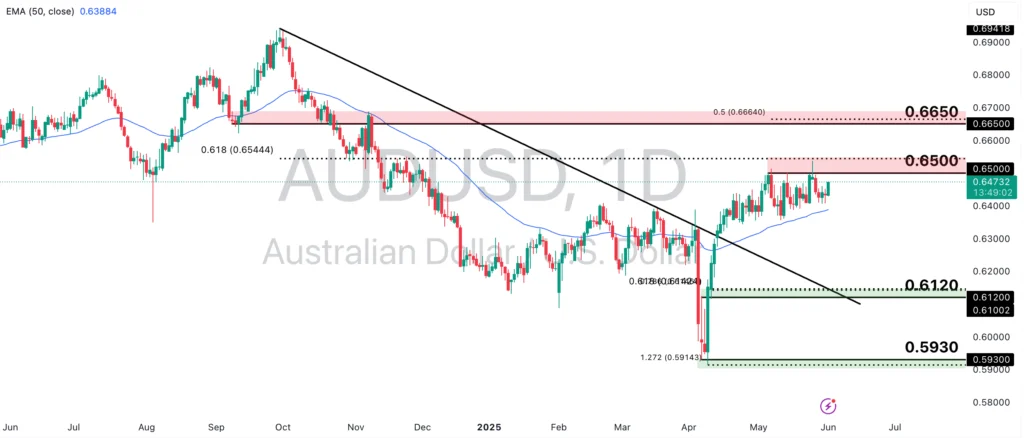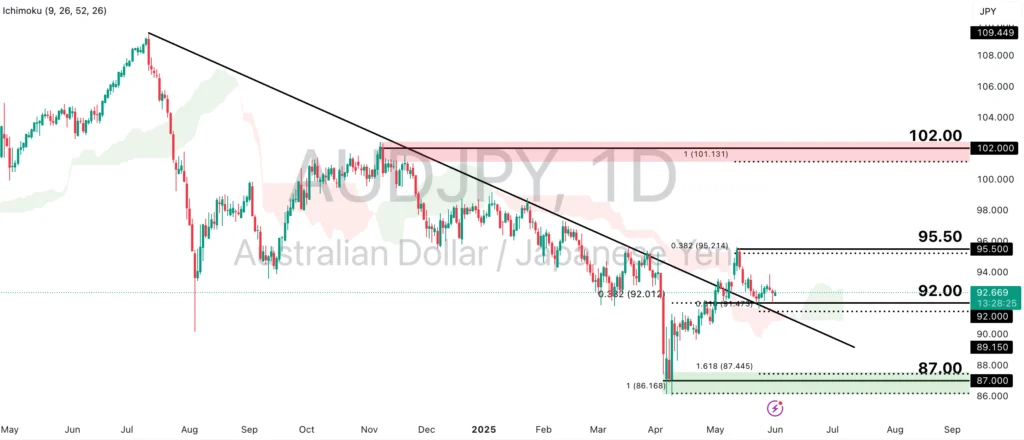RBA on the Edge: What’s Next for the Aussie?

The Reserve Bank of Australia (RBA) is under scrutiny with every move and every word closely monitored. RBA Governor Michele Bullock has recently said that if inflation stays “down sustainably”, the central bank might have the opportunity to lower rates further. This has fueled hope among traders, who are anticipating additional rate cuts following the RBA’s decision to reduce interest rates to 3.85% in its latest decision.
Economic Data at a Glance
Latest economic data releases showed Australia’s inflation rate holding steady at 2.4% in Q1 2025, which is the lowest level since Q1 2021. The labour market remains robust, with the unemployment rate at a low of 4.1%. However, the data showed that manufacturing activity weakened for the second consecutive month in May, falling to its lowest level since February. Additionally, retail sales unexpectedly declined in April, raising concerns over the country’s economic outlook.
Going forward, traders are expecting to see a steady path towards consistent rate cuts to support the domestic economy. However, this is contingent on inflation staying within the 2-3% target band. Should inflation look to pick up again, the rate-cutting path could be derailed.
AUDUSD Trades Sideways Post-RBA Rate Cut
AUDUSD has been stuck in a sideways range since the RBA’s latest rate cut, signalling some caution about its continued strength. That said, the pair could find support from a softening U.S. dollar, fueled by growing concerns over President Trump’s tariff policies. If Australia’s economy regains momentum, demand for the Aussie could pick up, providing a tailwind for the currency.

AUDUSD is testing the resistance zone at 0.6500, in line with the 61.8% Fibonacci Retracement level. At this point in time, bullish momentum looks to still be in force, as the price has broken above the descending trendline and is now holding above the 50-EMA. A continuation of this momentum would see the price break and close above the 0.6500 level and push towards the next resistance at 0.6650, in line with the 50% Fibonacci Extension level.
However, a deeper retracement could see the price approach the 0.6120 support zone, in line with a Fibonacci confluence zone. A break below the 0.6120 support could prompt a decline towards the 0.5930 swing low support, in line with the 127.2% Fibonacci Extension level.
AUDJPY Shows Bullish Potential
The Aussie shows potential for bullish moves against the Japanese yen, supported by Australia’s relatively lower exposure to U.S. trade tariffs compared to Japan. While both economies are affected by global trade tensions, Japan’s heavy reliance on auto exports makes it more vulnerable to U.S. tariff measures. In contrast, Australia’s diversified export base, particularly in commodities, offers a bit more resilience.
However, the Bank of Japan (BoJ) has recently taken a more hawkish stance, with BoJ Governor Ueda reaffirming the central bank’s commitment to raising interest rates if economic conditions align. This shift toward tightening could support the Japanese yen and temper gains in AUDJPY.

AUDJPY has also shown a breakout above the descending trendline resistance and is now pulling back to retest the 92.00 support level, in line with the 38.2% Fibonacci Retracement and 61.8% Fibonacci Extension levels. A deeper retracement could see the price move lower towards the 87.00 swing low support, in line with the 100% and 161.8% Fibonacci Extension levels.
However, as the price now holds above the Ichimoku cloud, we could see a continuation of bullish momentum. This could see the price move push higher towards the 95.50 swing high resistance, in line with the 38.2% Fibonacci Extension level, and subsequently the 102.00 resistance zone, in line with the 100% Fibonacci Extension level.
As the RBA navigates a delicate balancing act between inflation control and economic growth, traders should proceed with caution. The potential for further rate cuts remains, but so does the risk of a policy shift that could send the Aussie in the opposite direction.
Traders should keep a close eye on comments from the RBA and key economic data releases, which could provide some insight and hints on the interest rate path. Key technical levels in AUDUSD and AUDJPY could guide traders in market moves, but with so many variables in play, prudence and risk management will be crucial.
